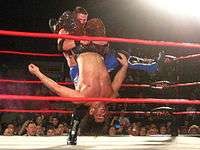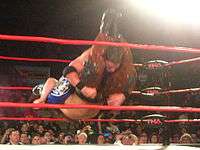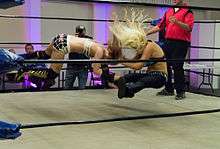Facebuster
A facebuster, also known as a faceplant, is generally a takedown move in professional wrestling in which an attacking wrestler forces their opponent down to the mat face-first without involving a headlock or facelock. A standard facebuster, also known as a jumping facebuster, involves the wrestler grabbing hold of the opponent's head/hair and dropping down to their knees, forcing the opponent's face into the mat.
Variants
Argentine facebuster
The attacking wrestler places an opponent in an Argentine backbreaker rack, where the opponent is held face-up across both the shoulders of the wrestler, from here the wrestler falls sideways (towards the side where the opponent's head is held) while still holding the opponent's head with one arm and flipping the opponent's legs over with the other, driving them down to the mat face-first. WWE wrestler Bianca Belair uses this moves and calls it K.O.D (Kiss Of Death)


From a position in which the opponent is bent forward against the wrestler's midsection, the wrestler grabs around his or her opponent's midsection and lifts so that the opponent is held upside down, facing in the same direction as the wrestler. The wrestler then hooks both arms of the opponent using his or her legs, and then falls forward planting the opponent's body into the mat face-first. The move often sees the wrestler keep their legs hooked under the arms of the opponent after hitting the move, using the underhooking technique to turn the opponent on to their back into a Rana style pinning position. This move was innovated by Col. DeBeers and was made famous by A.J. Styles, who refers to the move as the Styles Clash. Styles performs the maneuver with a variation, as seen in the photos to the right: he does not hook the opponent's arms before performing the slam, but takes two steps and moves his legs in front of the opponent's arms enabling him to use his legs to cover the shoulders for a pin. This variant is later utilized by former WWE Diva Michelle McCool, who referred to the move as the Faith Breaker. Cesaro uses a variation called the Neutralizer where he grapevines the opponents leg with his arm similar to a cradle piledriver.
Belly-to-back facebuster
Like a belly-to-back suplex, the attacking wrestler wraps their arms around the opponent in a waistlock and lifts the opponent in the air, and falls forward into a facebuster. Brooke Tessmacher used this as her finisher and called it the tess-shocker
Swinging belly-to-back facebuster
The opponent is lifted in sidewinder suplex position before being swung around and driven face first into the mat by the attacker.
Diving facebuster
This variation sees the wrestler grab a hold over the opponent's head/hair, then climb to the second rope or and finally jump from there dropping to their knees or in a sitout position and planting the opponent face first to the mat. In another variation the wrestler could just jump from the turnbuckle grabbing the opponent's head/hair in the air and planting them to the mat.
Double underhook facebuster
The wrestler bends their opponent forward, placing the opponent's head between the wrestler's legs and then applies a double underhook on the opponent. The wrestler performs a kneeling or sitout facebuster. It is perhaps better known as a Pedigree, the name Triple H gave to the kneeling version of the move as his finisher. Chyna later adopted the move from Triple H and began using it as a finisher. Another similar version of the Pedigree was used by Seth Rollins, where he would release his opponent during the fall, while a sitout version, known as In Yo' Face, is the name Velvet Sky gave to the move as her finisher.
Inverted double underhook facebuster
The wrestler stands behind and facing the same way as their opponent and hooks both their arms. The wrestler then places their head next to the opponent's back and turns 180 degrees while twisting one of the opponent's arms over both of their heads. With the wrestler now in front of the opponent and still hooking the opponent's arms, the wrestler drops onto their back, driving the opponent down face-first into the mat. Innovated by Tommy Rogers as the Tomikaze, it was popularized by Christian, who used this move as a finisher in WWE/TNA; it is perhaps better known as the Killswitch, but he has previously called it the Impaler (1998–1999) and the Unprettier (1999–2009). Juice Robinson uses a jumping variation, calling it Pulp Friction. Candice Michelle used this move and called it Candywrapper, Chelsea Green uses the move as her finisher calling it the I'm Prettier . Lio Rush uses a variation where him and the opponent would spin a full 360°.Tyler Breezeis also among notable wrestlers who use the move and he refers to it as The Unprettier
Lifting double underhook facebuster
Innovated by Gran Apache, this facebuster is performed when a wrestler bends an opponent forward, placing the opponent's head between the wrestler's legs (a standing head scissors), and hooks each of the opponent's arms behind their back. The wrestler then pulls back on the opponent's arms lifting him/her up so that the opponent is held upside down facing in the same direction as the wrestler, as if the performer was going for a double underhook piledriver, the wrestler then falls forward to a kneeling position planting the opponent's body into the mat face-first. A sit-out variation of this move exists. This maneuver was popularized by Christopher Daniels, uses a spinning sit-out version of the move and calls it the Angel's Wings. Awesome Kong uses a kneeling version as her finisher, known as the Implant Buster Tommaso Ciampa uses this move he calls it 'Fairy Tale Ending' while Mandy Rose currently uses a sitout version of the move, known as the Bed of Roses.
Electric chair facebuster
The wrestler approaches the opponent from behind, and lifts him on his shoulders into a seated position, the electric chair. The wrestler then lifts the opponent up by his thighs and pushes him forward and down, slamming him down to the mat chest first. The wrestler may also sit down while slamming the opponent.
Fireman's carry facebuster
This facebuster variation sees a wrestler lift an opponent up in a fireman's carry across his shoulders then throw the opponent's legs out in front of him to spin them out while he simultaneously falls backwards or forwards, causing the opponent to land on his face and upper body. Popularized by Brock Lesnar as the F-5.
Front facelock drop
The wrestler applies a front facelock to the opponent and then throws their legs out behind them, falling onto their stomach and driving the opponent's face into the mat. It is similar to a standard DDT, except it targets the face of the victim rather than the head, and the wrestler falls onto their stomach instead of falling back as they would in a DDT. It was used by Seth Rollins.
Full nelson facebuster
The attacking wrestler stands behind, slightly to one side of and facing the opponent before reaching under the opponent's arms with his/her own corresponding arms and places the palms of his/her hands on the neck of the opponent, thereby forcing the arms of the opponent up into the air (as in a full nelson hold). The attacking wrestler next hooks the opponent's near leg and throws themselves forwards, driving the opponent face first into the ground.
Gory bomb
This back-to-back release facebuster is a variation of the Gory special where a wrestler would release the arms of the opponent to take hold of the opponent's legs while dropping to a seated position, forcing the opponent to fall forward and impact the mat face-first. The move is named after the innovator of the original Gory special, Gory Guerrero. WWE wrestler Kay Lee Ray uses this move.
Inverted double leg slam
Also known as an inverted Alabama Slam, this move usually starts with the opponent sitting on an elevated position such as the top turnbuckle, with the attacking wrestler, standing in front of him/her facing the same direction, positioning the opponent's legs over their shoulders. Then the attacking wrestler detaches from the turnbuckle, so that the opponent is held upside down in a back-to-back position. From this position the attacking wrestler bends over, flipping the opponent over their head, slamming him/her down to the mat face-first. The attacking wrestler may also sit down while slamming the opponent. Drew McIntyre currently uses this moves as a transitional move.
Inverted swinging facebuster
This version of a facebuster sees the wrestler place an opponent in an inverted facelock while holding the facelock, twisting him or her into the facebuster and landing with their legs spread apart, driving the opponent's face into the mat. Velvet Sky used a variation of this move, she'd have her opponent in an inverted face lock, then grab one of the opponents arms and pull. Rotating the opponent so that the front of the body faces the mat and is in between her legs, driving down to the mat and ending in a facebuster.
Kneeling facebuster
The wrestler grabs the opponent by the head or hair and jumps in the air, landing in a kneeling position and driving the opponent's face into the mat. A slight variation of the kneeling facebuster sees a wrestler fall into the kneeling position while having the opponent's head between their legs and pushing the opponent down with their hands.
Over the shoulder facebuster
Also known as a powerslam facebuster, this variation sees the wrestler lifting the opponent onto their shoulders as in a front powerslam. Then as the opponent is on the shoulder, the wrestler jumps and slams the opponent face-first to the mat. A cutter variation also exists. WWE wrestler Big E uses this move as a finisher, calling it the Big Ending.
Powerbomb facebuster
This variation of the facebuster sees the wrestler seating his opponent over his own shoulders, as in a powerbomb. From this point, the wrestler pushes the opponent off his shoulders, and grabs the opponent's head with both hands, and drops seated or kneeled to hit a sitout or kneeling facebuster.
Push-up facebuster
A variation where a wrestler puts the head of his opponent between his legs as he performs a number of push-ups, causing the opponent's face to be slammed into the canvas a number of times. Often instead of straight push ups, the attacking wrestler just bounces his legs up and down to create the effect.
Reverse chokeslam facebuster
The attacking wrestler grabs hold of an opponent's neck with both hands, one on the front, and one on the back. The arm that has the hand on the back of the neck may hook the opponent's arm. The wrestler then lifts the opponent up, releases the hand holding the front of the opponent's neck, and pushes forward and slams the opponent to the mat face-first with the other hand.[1][2] Braun Strowman rarely uses this move as his finisher.
A wrestler pushes their opponent upward by reaching under their legs and lifting them into the air. While retaining the hold on the opponent's leg, the wrestler falls backwards, dropping the opponent front-first into the canvas. It is commonly used when an opponent is charging. The move is similar to a back body drop, but the wrestler pushes upwards so that their opponent falls on to their face instead of falling back-first.
Shoulder facebuster
Also known as a hangman's facebuster, this facebuster is performed when an attacking wrestler, who is standing in a back-to-back position with an opponent, reaches back to pull the opponent's head over their shoulder before (while keeping a hold of the opponent's head) falling forwards to twist the opponent's head over so they slam face first into the mat.[3] This move is the finisher of Curtis Axel, which he calls the Axehole.
Sitout facebuster

Also known as the X-Factor. This is the most common variation of the standard facebuster in which the attacker grabs hold of the opponent by their head then jumps in the air, lifting the opponent and landing with their legs spread apart, driving the opponent's face into the mat. Another variation of this move is to grab the opponent by the hair, perform the same jump and landing but lift only the opponent's head, giving a harder effect when the opponent's face is driven into the mat. This move was popularized by Sean Waltman and The Bella Twins.
Spinning facebuster
Also known as a tornado facebuster, this variation sees the attacker grabbing hold of the opponent by their hair and then spinning in the air, landing in a kneeling position and driving the opponent's face into the mat. This maneuver was popularized by Melina.
Vertical suplex facebuster
Also called a front suplex or a gourdbuster, this move sees attacker apply a front face lock to the opponent and drape the opponent's near arm over their shoulder. The attacker then lifts the opponent into a vertical position, then he falls forward, driving the opponents face into the ground.
Wheelbarrow facebuster
This facebuster sees the attacking wrestler grab a standing opponent around the waist from behind and lift them into a backdrop position before then falling to a sitting position, swinging the opponent down so that their face is driven into the ground. A variant, sees the wrestler lift the opponent's legs around their waist before placing both hands around the opponent's waist and lifting them into a wheelbarrow position. The wrestler then elevates their opponent into the air before performing a seated drop, driving their opponent's face into the canvas.
Belly-to-back wheelbarrow facebuster
A variation to the wheelbarrow facebuster which sees the attacking wrestler stand at the side of an opponent and begin to lift them as for a belly-to-back suplex. Instead of falling backwards to drop the opponent back-first, the wrestler stops after lifting the opponent, grabs a hold of their legs while still holding the opponent up, and slams him/her face-first on to the mat. Jushin "Thunder" Liger is well known for using this move as a finisher, calling it the Crash Thunder Buster.
Hook and Ladder

The wrestler hooks both an opponent's arms in an elevated double chickenwing, lifts them up into the air from behind, then drops the opponent down onto the mat face first. There is also a sitout variation, where a wrestler hooks their opponent's legs and drops to a seated position, while planting the opponent's face into the canvas between the wrestler's legs. Popularized by Beth Phoenix who used this as her finisher called the Glam Slam.
Reverse STO
Also known as the Complete Shot or Flatliner, this is a move in which a wrestler stands side-to-side and slightly behind with the opponent, facing in the opposite direction, and reaches around the opponent's torso with one arm across the opponent's chest with their hand holding on to their other hand which is behind the opponent's head. The wrestler then falls backward, driving the opponent into the mat face-first. The wrestler can also cross their leg between the opponent's leg before hitting the reverse STO, with this slight variation being known as a leg hook reverse STO, once used as a finisher both by former WWE and TNA wrestler Ken Anderson known as the Mic Check, and by WWE Hall of Famer Edge, known as the Downward Spiral.[4] This move can be used to transition into various submissions. The move is commonly used to transition into the Code of Silence, a modified figure-four headscissor (utilized by Carmella) or a Koji Clutch.
Arm trap reverse STO
This move sees the wrestler stand side to side with the opponent, tucking his arm behind the opponent's head at a 90° angle and putting his near leg in front of the opponent's closest leg. The wrestler then pushes the opponent forward and quickly pulls them backward, with the attacker landing on their back whilst the opponent falls face first.
Elevated reverse STO
In this variation the wrestler first locks the opponent in a standard Reverse STO lock, then sees the opponent and put his ankles on some elevated surface (usually top rope, or turnbuckle, or barricade outside of the ring), the wrestler then falls backward, driving the opponent face-first into the mat. Another variation of this move including the opponent standing on the apron outside of the ring, and attacking wrestler first grabs opponent and pulls him over the top rope until opponent's ankles match the ropes, the attacking wrestler then falls backward, driving the opponent face-first into the mat. Tommaso Ciampa used this move at NXT TakeOver: Toronto in a match against Scott Dawson.
Leaping reverse STO
A variation of the reverse STO, this move see the wrestler jumping up towards the side of an opponent and grabbing his head before falling backwards onto the mat, planting the opponent face-first. The move has been used by various professional wrestlers such as Mil Muertes (the Flatliner), Shelton Benjamin (the Paydirt), Montel Vontavious Porter (the Play of the Day/305) and R-Truth (Lil' Jimmy).
Lifting reverse STO
A slight variation of the reverse STO, this move sees a wrestler perform exactly the same set-up but instead of falling backward immediately, they lift the opponent before dropping them face-first into the mat, making it similar to a flapjack. It was innovated by Chris Kanyon. Baron Corbin's finisher is a variant of this move called the End of Days while Angelina Love uses the move as a signature (previously a finisher) called Lights Out. Another variation of this move involves using a pumphandle lift where the wrestler sets the opponent up for a pumphandle hold and then lifts them into the execution of the move. Pete Dunne uses this variation as a finisher previously calling it Drop Dead but now known as the Bitter End.
Swinging reverse STO
Another variation of the reverse STO, this move sees a wrestler grab their opponent around their neck and lean them backwards. The wrestler then swings their opponent around, slamming them face-first into the mat. Bray Wyatt uses this maneuver as his finisher, which he calls Sister Abigail. NJPW wrestler Switchblade Jay White uses a variation called Blade Runner. Mike Knox, a Former WWE star, calls it "The Knoxout".
See also
References
- Caldwell, James. "Caldwell's WWE No Way Out report 2/17: Ongoing "virtual time" coverage of PPV". Pro Wrestling Torch. Retrieved 24 November 2011.
- Martin, Adam. "Genesis PPV Results - 1/17/10". Wrestleview. Retrieved 24 November 2011.
- Bishop, Matt (November 25, 2010). "Superstars: Henry looks for revenge of Usos". SLAM! Sports. Retrieved 2010-11-26.
- "The Finish Line 10.04.04: Totally Reeking Of Awesomeness October 4, 2004 posted by Matt Nute"